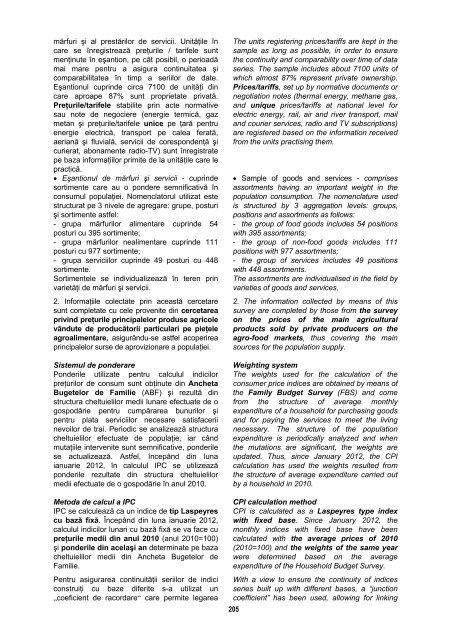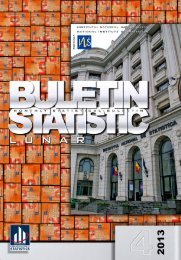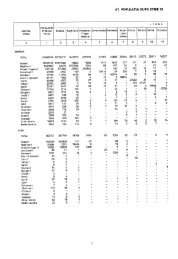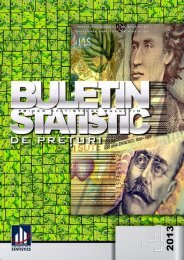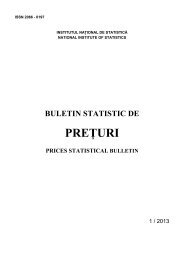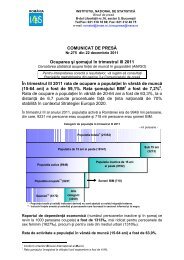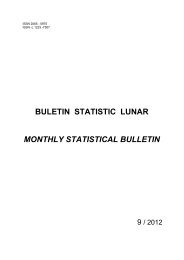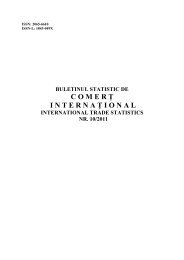BULETIN STATISTIC LUNAR MONTHLY STATISTICAL BULLETIN
BULETIN STATISTIC LUNAR MONTHLY STATISTICAL BULLETIN
BULETIN STATISTIC LUNAR MONTHLY STATISTICAL BULLETIN
Create successful ePaper yourself
Turn your PDF publications into a flip-book with our unique Google optimized e-Paper software.
mărfuri şi al prestărilor de servicii. Unităţile în<br />
care se înregistrează preţurile / tarifele sunt<br />
menţinute în eşantion, pe cât posibil, o perioadă<br />
mai mare pentru a asigura continuitatea şi<br />
comparabilitatea în timp a seriilor de date.<br />
Eşantionul cuprinde circa 7100 de unităţi din<br />
care aproape 87% sunt proprietate privată.<br />
Preţurile/tarifele stabilite prin acte normative<br />
sau note de negociere (energie termică, gaz<br />
metan şi preţurile/tarifele unice pe ţară pentru<br />
energie electrică, transport pe calea ferată,<br />
aeriană şi fluvială, servicii de corespondenţă şi<br />
curierat, abonamente radio-TV) sunt înregistrate<br />
pe baza informaţiilor primite de la unităţile care le<br />
practică.<br />
• Eşantionul de mărfuri şi servicii - cuprinde<br />
sortimente care au o pondere semnificativă în<br />
consumul populaţiei. Nomenclatorul utilizat este<br />
structurat pe 3 nivele de agregare: grupe, posturi<br />
şi sortimente astfel:<br />
- grupa mărfurilor alimentare cuprinde 54<br />
posturi cu 395 sortimente;<br />
- grupa mărfurilor nealimentare cuprinde 111<br />
posturi cu 977 sortimente;<br />
- grupa serviciilor cuprinde 49 posturi cu 448<br />
sortimente.<br />
Sortimentele se individualizează în teren prin<br />
varietăţi de mărfuri şi servicii.<br />
2. Informaţiile colectate prin această cercetare<br />
sunt completate cu cele provenite din cercetarea<br />
privind preţurile principalelor produse agricole<br />
vândute de producătorii particulari pe pieţele<br />
agroalimentare, asigurându-se astfel acoperirea<br />
principalelor surse de aprovizionare a populaţiei.<br />
Sistemul de ponderare<br />
Ponderile utilizate pentru calculul indicilor<br />
preţurilor de consum sunt obţinute din Ancheta<br />
Bugetelor de Familie (ABF) şi rezultă din<br />
structura cheltuielilor medii lunare efectuate de o<br />
gospodărie pentru cumpărarea bunurilor şi<br />
pentru plata serviciilor necesare satisfacerii<br />
nevoilor de trai. Periodic se analizează structura<br />
cheltuielilor efectuate de populaţie, iar când<br />
mutaţiile intervenite sunt semnificative, ponderile<br />
se actualizează. Astfel, începând din luna<br />
ianuarie 2012, în calculul IPC se utilizează<br />
ponderile rezultate din structura cheltuielilor<br />
medii efectuate de o gospodărie în anul 2010.<br />
Metoda de calcul a IPC<br />
IPC se calculează ca un indice de tip Laspeyres<br />
cu bază fixă. Începând din luna ianuarie 2012,<br />
calculul indicilor lunari cu bază fixă se va face cu<br />
preţurile medii din anul 2010 (anul 2010=100)<br />
şi ponderile din acelaşi an determinate pe baza<br />
cheltuielilor medii din Ancheta Bugetelor de<br />
Familie.<br />
Pentru asigurarea continuităţii seriilor de indici<br />
construiţi cu baze diferite s-a utilizat un<br />
„coeficient de racordare“ care permite legarea<br />
The units registering prices/tariffs are kept in the<br />
sample as long as possible, in order to ensure<br />
the continuity and comparability over time of data<br />
series. The sample includes about 7100 units of<br />
which almost 87% represent private ownership.<br />
Prices/tariffs, set up by normative documents or<br />
negotiation notes (thermal energy, methane gas,<br />
and unique prices/tariffs at national level for<br />
electric energy, rail, air and river transport, mail<br />
and courier services, radio and TV subscriptions)<br />
are registered based on the information received<br />
from the units practising them.<br />
• Sample of goods and services - comprises<br />
assortments having an important weight in the<br />
population consumption. The nomenclature used<br />
is structured by 3 aggregation levels: groups,<br />
positions and assortments as follows:<br />
- the group of food goods includes 54 positions<br />
with 395 assortments;<br />
- the group of non-food goods includes 111<br />
positions with 977 assortments;<br />
- the group of services includes 49 positions<br />
with 448 assortments.<br />
The assortments are individualised in the field by<br />
varieties of goods and services.<br />
2. The information collected by means of this<br />
survey are completed by those from the survey<br />
on the prices of the main agricultural<br />
products sold by private producers on the<br />
agro-food markets, thus covering the main<br />
sources for the population supply.<br />
Weighting system<br />
The weights used for the calculation of the<br />
consumer price indices are obtained by means of<br />
the Family Budget Survey (FBS) and come<br />
from the structure of average monthly<br />
expenditure of a household for purchasing goods<br />
and for paying the services to meet the living<br />
necessary. The structure of the population<br />
expenditure is periodically analyzed and when<br />
the mutations are significant, the weights are<br />
updated. Thus, since January 2012, the CPI<br />
calculation has used the weights resulted from<br />
the structure of average expenditure carried out<br />
by a household in 2010.<br />
CPI calculation method<br />
CPI is calculated as a Laspeyres type index<br />
with fixed base. Since January 2012, the<br />
monthly indices with fixed base have been<br />
calculated with the average prices of 2010<br />
(2010=100) and the weights of the same year<br />
were determined based on the average<br />
expenditure of the Household Budget Survey.<br />
With a view to ensure the continuity of indices<br />
series built up with different bases, a “junction<br />
coefficient” has been used, allowing for linking<br />
205


